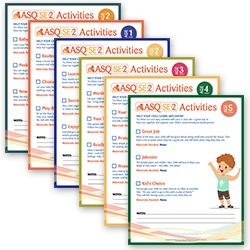3 Reasons Why ASQ Works Great for Home Visiting Programs

Early childhood home visiting professionals collaborate with families to create a healthy, nurturing environment where young children can learn and thrive. Because a big part of healthy development is regular screening, home visiting programs should be using a reliable tool like ASQ® with every young child they work with.
Home visiting programs like Healthy Families America, Parents as Teachers, and Nurse-Family Partnership already trust ASQ®-3 and ASQ®:SE-2 to check children’s developmental progress and ensure that potential delays are caught early. But what are some of the other benefits for home visiting programs that adopt ASQ? Here are three big ways that ASQ helps support the objectives of early childhood professionals who provide essential, in-home services to the families of young children.
1. ASQ helps form strong partnerships with families
 Because ASQ-3 and ASQ:SE-2 are parent-completed tools, families assume a vital role in the screening process from the very beginning. Whether parents and caregivers fill out the ASQ questionnaires themselves or with the assistance of a home visitor, the screening process depends on the knowledge and expertise of the people who know the child best. Home visitors who use ASQ soon discover that the process is filled with natural opportunities to strengthen their relationship with families. Letting parents know what to expect before screening, sensitively discussing results after screening, reviewing possible follow-up actions like monitoring or assessment, and sharing appropriate resources to help parents support the next stage of development—these are all perfect conversational openings to engage family members and show them new ways to promote their child’s progress.
Because ASQ-3 and ASQ:SE-2 are parent-completed tools, families assume a vital role in the screening process from the very beginning. Whether parents and caregivers fill out the ASQ questionnaires themselves or with the assistance of a home visitor, the screening process depends on the knowledge and expertise of the people who know the child best. Home visitors who use ASQ soon discover that the process is filled with natural opportunities to strengthen their relationship with families. Letting parents know what to expect before screening, sensitively discussing results after screening, reviewing possible follow-up actions like monitoring or assessment, and sharing appropriate resources to help parents support the next stage of development—these are all perfect conversational openings to engage family members and show them new ways to promote their child’s progress.
It’s important to stress with families that ASQ questionnaires not only identify potential delays or areas of concern, they also highlight areas where a child’s skills meet expectations for their developmental age. Taking the time to celebrate a child’s strengths can help home visitors build a positive rapport with families and increase parents’ confidence in their own caregiving abilities. Parents who feel competent and involved are much more likely to embrace their essential role in helping their child make progress, and they may be more eager to put their home visitor’s suggestions into practice between visits.
2. ASQ educates parents on their child’s growth and development
 ASQ is more than a screener—it’s a system designed to help expand parents’ knowledge of child development and increase their capacity to support their child’s progress between screenings. Reviewing the ASQ-3 and ASQ:SE-2 questionnaires with families is a perfect way for home visitors to educate them about which behaviors and skills they might expect to see along each step of a child’s developmental journey. The questionnaire items also highlight specific, age-appropriate milestones that some families might not be aware of. For instance, a parent or caregiver with a 3-year-old child might not realize that safety scissors are developmentally appropriate, until they see the item about cutting paper in the Fine Motor section of the ASQ-3 36-month questionnaire.
ASQ is more than a screener—it’s a system designed to help expand parents’ knowledge of child development and increase their capacity to support their child’s progress between screenings. Reviewing the ASQ-3 and ASQ:SE-2 questionnaires with families is a perfect way for home visitors to educate them about which behaviors and skills they might expect to see along each step of a child’s developmental journey. The questionnaire items also highlight specific, age-appropriate milestones that some families might not be aware of. For instance, a parent or caregiver with a 3-year-old child might not realize that safety scissors are developmentally appropriate, until they see the item about cutting paper in the Fine Motor section of the ASQ-3 36-month questionnaire.

The ASQ-3 and ASQ:SE-2 Learning Activities are also an invaluable resource for teaching families how to improve their interactions with young children and nurture development between home visits and screenings. Covering birth to age 6, these simple, fun activities are easy to print or email and use common materials that most families already have around the house. They’re the perfect way for home visitors to help increase the number and quality of parent-child interactions, show parents how to foster early developmental and social-emotional skills, and provide children with opportunities to practice skills in areas where they might need a little help.
3. ASQ makes it easy to provide referrals for community services
 Home visiting programs regularly connect families with community resources related to mental health, housing, employment, and other crucial services, and ASQ can help inform and ease the referral process. Once a child’s ASQ-3 or ASQ:SE-2 questionnaire is scored, the results will help inform what kind of follow-up steps will be appropriate, whether it’s referring the child for further evaluation, sharing learning activities with parents, or providing information about parent support groups and other community resources. (See this quick guide for an overview of ASQ Referral Tips.)
Home visiting programs regularly connect families with community resources related to mental health, housing, employment, and other crucial services, and ASQ can help inform and ease the referral process. Once a child’s ASQ-3 or ASQ:SE-2 questionnaire is scored, the results will help inform what kind of follow-up steps will be appropriate, whether it’s referring the child for further evaluation, sharing learning activities with parents, or providing information about parent support groups and other community resources. (See this quick guide for an overview of ASQ Referral Tips.)
Because ASQ is so widely used, it’s easy for home visitors to talk about screening results with a wide range of other professionals who work with children. Phrases like “He’s below the cutoff for ASQ-3” or “She’s above the cutoff for ASQ:SE-2” have become shorthand for professionals in multiple settings, including primary care providers, early interventionists, early childhood special educators, parent educators, and behavioral health specialists. The shared language of ASQ helps ensure that all members of the early childhood support team are on the same page and working toward a common goal: strengthening the families in your community and improving school readiness for every child.
Home visiting programs and ASQ are a perfect match. When home visitors use proven, reliable developmental and social-emotional screeners with young children, it’s easier for them to fulfill their mission—laying the groundwork for a developmentally rich home environment that promotes each child’s healthy development.
Further Reading
Read a Q&A with ASQ developer Jane Squires on setting guidelines for referrals.
Find out about the free Environmental Screening Questionnaire (ESQ™), a parent-completed screening tool that helps you gather information about children’s home environments.
Download a helpful tip sheet on sharing ASQ results with parents.


